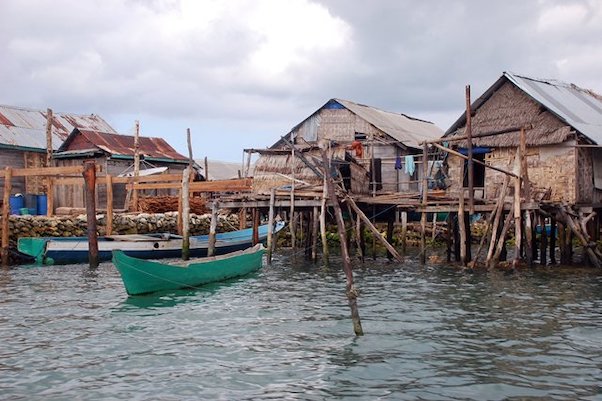PHILIPPINES
A Life at Sea
By Chadd McGlone
Chapel Hill, NC, United States
The Bajau people live on — not at, near, or beside — but on, the Sulu Sea in the South Pacific, subsisting on the fish they catch and the supplies they gather from nearby islands. By living literally on the water, some Bajau spend their entire lives with their whole families on lepa-lepa boats that are typically just 15 feet (ft.) long by 5 ft. wide. The average family size is between four and eight members.
Daily Life on the Sea
A typical day begins with the patriarch waking his family at daybreak to motor to their fishing spot. The entire Bajau fishes together using hand-made nets and spears. The father freedives to spear the fish, spending as many as five minutes underwater. When he surfaces with a catch, he tosses it onto the boat for the children gather and the wife to clean. Next, they cook the fish over a small fire in the stern of the boat.
After a quick meal, the family might travel to a nearby island to collect supplies and water. They gather branches and scrap wood left by local lumber workers to repair their boat. Bajau communities build wells to be shared among the people. The mother will take older children to the well to return with as much water as they can carry.
Permanent Homes
In contrast to these sea-dwelling families, other Bajau have moved to more permanent dwellings off the shorelines of various islands. They construct these stilt homes themselves, using local timber. The houses’ supports are cut from palm branches and anchored into the sea floor. The residents then weave palm leaves together to form wind- and rain-resistant walls.

Stilt-home villages contain dwellings that are 40 to 50 sq. ft. in size and are connected by various walkways. Each house is surrounded entirely by water and provides shelter for 10 to 15 people.
The economy in these stilt-home villages is driven almost entirely by profits from freshly harvested ocean creatures. A particular delicacy of the Bajau is the sea cucumber, a chewy, tasteless, invertebrate creature that acquires the flavor of whatever it’s cooked in. Many who love sea cucumber say it is an acquired taste, one that many have never acquired. Maybe this is one place where you don’t have to eat your veggies!
Have a suggestion for this story? We’d love for you to submit it!


Blank
Blank
Math Resources
- If you lived on a lepa-lepa boat with your family of six, about how much space could you claim each night to sleep?
- In groups, use string to lay out a lepa-lepa boat on the floor. Now, determine how you might use that space during dinner. Would you set aside a space for preparing the food or cleaning afterwards?
- On graph paper, design a stilt home for 12 people. If the home must be no more than 50 sq. ft., what dimensions might you use? Remember, you must place the bathroom (a hole in the floor) at the side of your home opposite the entry.
- How much wood, how many people and tools are needed to complete a 15 ft. long by 5 ft. wide lepa-lepa boat?
Social Justice Questions
- Climate change presents a threat to Bajau traditions. How would you expect rising sea levels and more frequent storms to affect the Bajau?
- Formal education that takes place in a classroom is not part of Bajau life. Children acquire knowledge and skills from their parents and extended community. Do you think the Philippine government should require Bajau children to attend school? How could it benefit the Bajau to transfer knowledge outside the classroom?
Explore Further
- More information about the Bajau people
- News story with portraits of Bajau life
- United Nations’ efforts to protect Bajau human rights
- News story on physical adaptations to aquatic living
- Video about Bajau freediving
Share Your Story
Write your own Global Math Story and send it to us!
Sorry, the comment form is closed at this time.